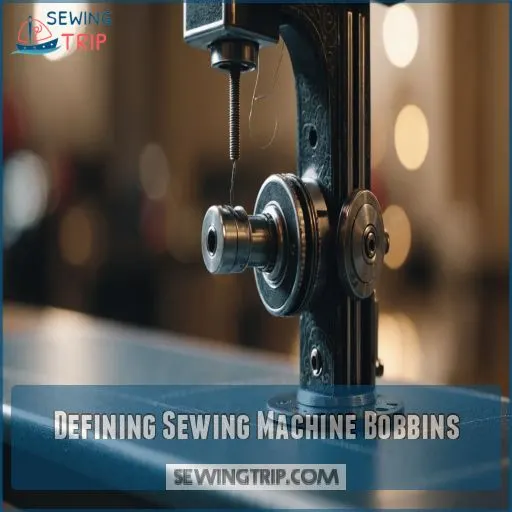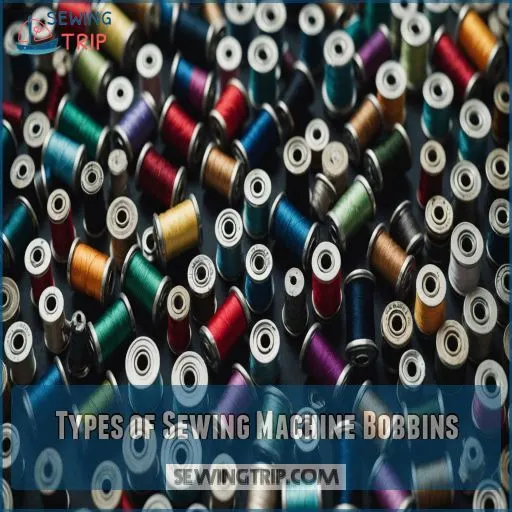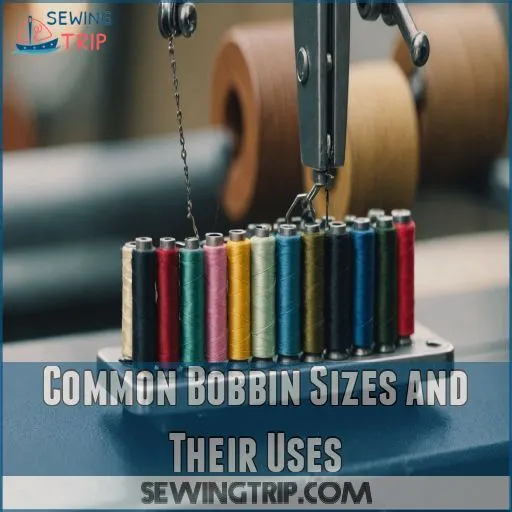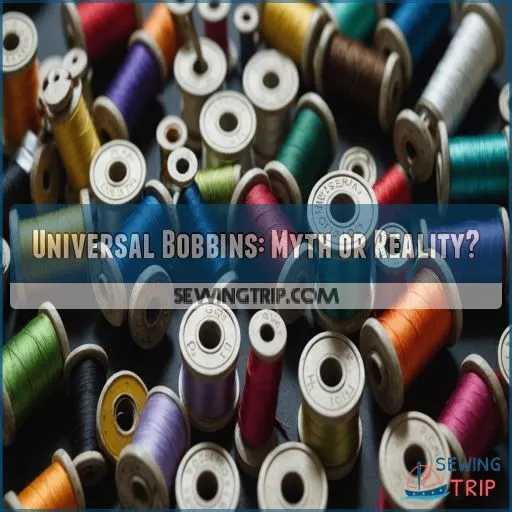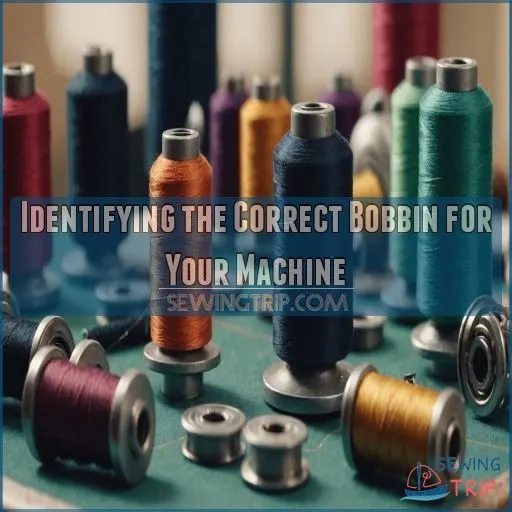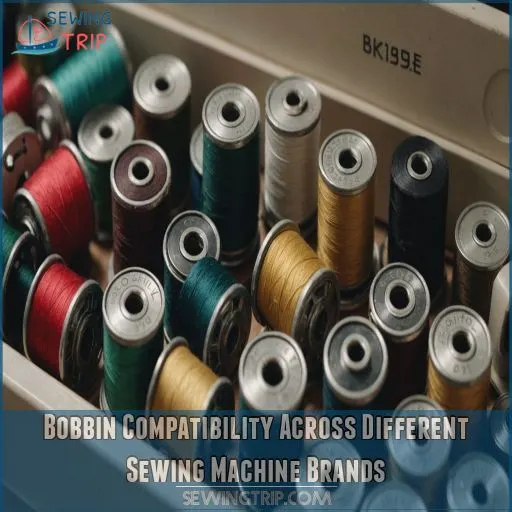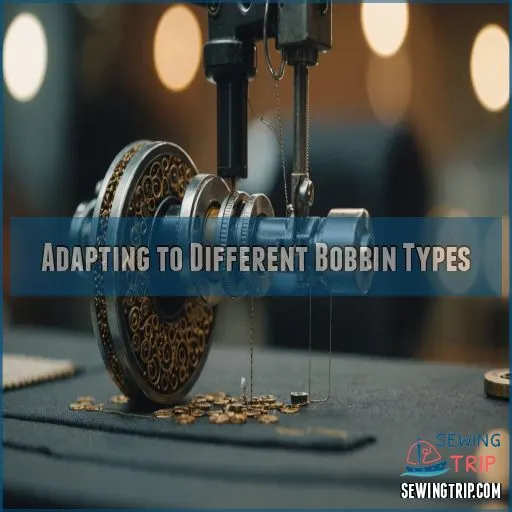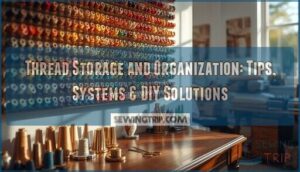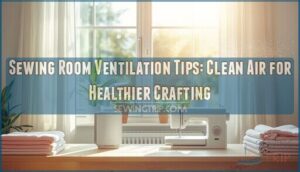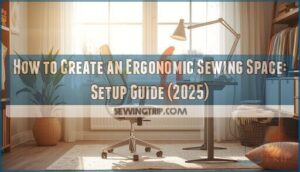This site is supported by our readers. We may earn a commission, at no cost to you, if you purchase through links.
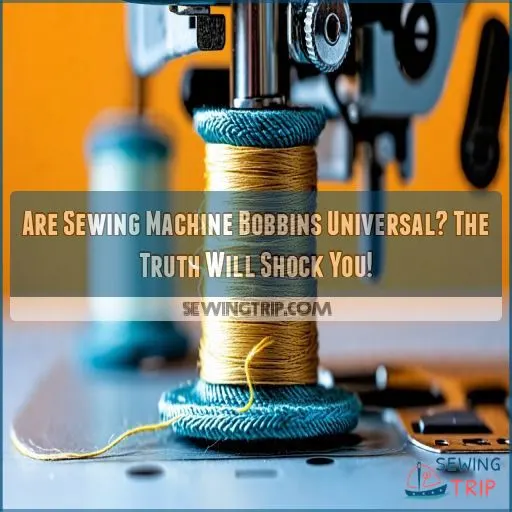
While some bobbins are more versatile than others, most machines have specific requirements.
You’ll find over 60 different styles out there, with Class 15, L Style, and M Style being the most common for home sewing.
Using the wrong bobbin can lead to a tangled mess or even damage your beloved machine. It’s important to match the bobbin to your machine’s specifications, considering size, shape, and material.
Don’t worry, though – with a bit of know-how, you’ll be threading the needle like a pro in no time!
Table Of Contents
- Key Takeaways
- Defining Sewing Machine Bobbins
- Types of Sewing Machine Bobbins
- Are Sewing Machine Bobbins Universal?
- Common Bobbin Sizes and Their Uses
- Plastic Vs. Metal Bobbins: Pros and Cons
- Universal Bobbins: Myth or Reality?
- Identifying the Correct Bobbin for Your Machine
- Bobbin Compatibility Across Different Sewing Machine Brands
- Adapting to Different Bobbin Types
- Frequently Asked Questions (FAQs)
- Conclusion
Key Takeaways
- You can’t just grab any bobbin off the shelf and expect it to work in your sewing machine. Like finding the perfect dance partner, you need to match your bobbin to your machine’s specifications to avoid a stitching tango gone wrong.
- While universal bobbins sound like a dream come true, they’re more of a "jack of all trades, master of none" situation. They might work in a pinch, but for the best results, stick to the bobbin type recommended in your machine’s manual.
- Don’t underestimate the power of these tiny thread-holders. Choosing between plastic and metal bobbins isn’t just about durability – it can affect your stitch quality and tension. It’s like picking the right ingredients for your favorite recipe; the wrong choice can leave a bad taste in your sewing.
- When in doubt, consult your sewing machine’s manual or a professional. It’s better to spend a few extra minutes finding the right bobbin than hours untangling a bird’s nest of thread from your machine’s innards.
Defining Sewing Machine Bobbins
You’ve probably seen those small, round things in your sewing machine but never quite understood their purpose.
These mysterious objects are called bobbins, and they’re essential for creating stitches by holding the lower thread that intertwines with the upper thread from your needle.
Function of Bobbins in Sewing Machines
Your sewing machine’s unsung hero, the bobbin, plays a vital role in creating those perfect stitches.
It’s the thread-holding workhorse that sits snugly in your machine’s underbelly, working in tandem with the top thread to form each stitch.
Whether you’re dealing with a drop-in or front-loading bobbin system, proper bobbintension and maintenance are key to achieving excellent stitch quality.
Remember, a well-wound bobbin is half the battle won! (Source)
Components of a Typical Bobbin
Let’s unravel the mystery of bobbin components. A typical bobbin consists of a core, flanges, and a contact post.
The core holds the thread, while flanges keep it neatly wound.
The bobbin case, which houses this little powerhouse, is also an essential part.
Some bobbins even sport a wire cutter for easy thread trimming.
Understanding these parts will help you become a bobbin whiz in no time!
Importance of Bobbins for Stitch Formation
The unsung hero of stitch formation, bobbins play a vital role in your sewing adventures. They hold the lower thread, working in tandem with the upper thread to create perfect stitches . Proper bobbin tension guarantees smooth thread release, preventing those pesky loops and bird nests. Without these little powerhouses, you’d be left with a one-sided mess instead of beautifully balanced seams.
- Thrill of achieving that elusive perfect stitch
- Frustration when bobbin issues derail your project
- Pride in mastering the art of bobbin tension
- Excitement of opening up new sewing possibilities
Common Materials Used in Bobbin Manufacturing
While sewing machine bobbins may look simple, they’re made from a variety of materials to suit different needs.
Plastic bobbins are lightweight and cost-effective, perfect for everyday sewing.
Metal bobbins, often made of aluminum, offer durability and precision for heavy-duty tasks.
Some vintage machines even use wooden or bone bobbins for a touch of nostalgia.
Choose wisely – the right material can make or break your sewing experience!
Types of Sewing Machine Bobbins
Diving into the world of sewing machine bobbins can feel like opening Pandora’s box. You’ll find over 60 different styles, each with its own quirks and charms.
The three musketeers of household sewing are Class 15, L Style, and M Style bobbins. Class 15, about the size of a nickel, comes in plastic and metal flavors.
L Style bobbins are slimmer cousins to Class 15, while M Style bobbins are the quarterbacks of the bunch, larger and in charge.
But wait, there’s more! You’ve got Singer 163131 bobbins with their nifty yardage indicators, and the cool-as-a-cucumber Singer 8228 for treadle machines.
Don’t forget about Class 66, Bernina, and Viking-specific bobbins. Each type plays an important role in bobbin tension and winding, so choosing the right one for your machine is key to smooth sailing in your sewing adventures.
Are Sewing Machine Bobbins Universal?
You might think all sewing machine bobbins are created equal, but that’s not quite the case.
While some bobbins are compatible across different machines, factors like size, shape, and your specific sewing machine model play a key role in determining which bobbin you’ll need.
Factors Affecting Bobbin Compatibility
Several key factors determine bobbin compatibility with your sewing machine. You’ll need to think about bobbin size, shape, and material to make sure you get smooth stitching. Thread type and tension settings also play important roles in achieving perfect seams.
Don’t forget to check your machine model’s specifications – using the wrong bobbin can lead to jams or even damage .
It’s like finding the right dance partner for your sewing machine – when everything clicks, you’ll be stitching up a storm!
Variations in Bobbin Sizes and Shapes
You might be surprised to learn that bobbin sizes and shapes aren’t one-size-fits-all. In fact, there are over 60 different styles.
Let’s unravel this thread:
- Class 15: Nickel-sized with flat sides
- L Style: Same diameter as Class 15, but narrower
- M Style: Quarter-sized, flat sides
- Class 66: Curved sides, fits black Apollo cases
Each type impacts your sewing differently. It’s like finding the right dance partner for your machine!
Machine-specific Bobbin Requirements
Precision is key when it comes to sewing machine bobbins. Different machines need specific bobbin styles for the best performance.
Let’s break down some common bobbin types and their compatibility:
| Bobbin Type | Compatible Machines | Key Features |
|---|---|---|
| Class 15 (A Style) | Most modern domestic machines | 20.3mm diameter, 11.7mm width |
| L Style | Various brands | 20.3mm diameter, 8.9mm width |
| M Style | Larger domestic machines | 24.9mm diameter, 10.7mm width |
Always check your sewing machine manual to make sure you’re using the right bobbin for your trusty stitching companion.
Risks of Using Incompatible Bobbins
Beneath the surface of your sewing machine lies a hidden danger: incompatible bobbins. They’re like wolves in sheep’s clothing, wreaking havoc on your stitching. Using the wrong bobbin can lead to thread tangling and jams due to diameter variations, which affect thread management and machine compatibility. Different sewing machines have varying tolerances for bobbin size discrepancies, making it especially important to choose the right one.
This is why investing in quality, original bobbins is essential for excellent sewing results, as they’re specifically designed to match the machine’s requirements, ensuring smooth sewing performance understanding bobbin sizes.
Using the wrong bobbin can lead to:
- Stitch quality issues that’ll make your projects look like a mess
- Thread tension problems, causing your fabric to pucker like a sour lemon
- Machine malfunctions that’ll have you pulling your hair out
Don’t let these tiny troublemakers derail your sewing dreams!
Common Bobbin Sizes and Their Uses
You’ll find that sewing machine bobbins come in various sizes, each designed for specific types of machines and projects.
From the common Class 15 for household machines to the larger Class 66 for industrial use, understanding these differences can save you from a tangled mess of thread and frustration.
Class 15 Bobbins for Household Machines
Many household sewing machines use Class 15 bobbins, about the size of a nickel. These versatile bobbins measure 20.3 mm in diameter and 11.7 mm in width, with two flat sides. Available in plastic and metal, they’re compatible with numerous machines, including longarm quilting machines, which often use L-style bobbins.
Additionally, some specialized machines like 10-needle embroidery machines require M-style bobbins.
To extend their lifespan, wind them evenly and store them properly. When selecting a replacement, make sure to check your machine’s manual to confirm compatibility, as even slight differences can cause tension issues.
Class 66 Bobbins for Industrial Applications
Now, let’s talk about Class 66 bobbins, the powerhouses of industrial sewing. You’ll find these little workhorses in heavy-duty machines that can sew at breakneck speeds . They’re built tough to handle the demands of industrial applications.
Here are three key features of Class 66 bobbins:
- Metal construction for durability
- Larger capacity for longer sewing runs
- Designed for high-speed industrial machines
Remember, using the right bobbin is like finding the perfect dance partner for your machine – it’s all about compatibility and rhythm!
L-style and M-style Bobbin Specifications
While industrial machines often use Class 66 bobbins, home sewers need to know about L-style and M-style bobbins. These common types have different dimensions and uses.
L-style bobbins are typically 20.3mm in diameter and 11.7mm tall. They’re great for everyday sewing.
M-style bobbins are slightly larger and often used in quilting machines.
Remember, using the right bobbin is key to achieving perfect tension in your projects!
Specialty Bobbins for Specific Machines
Beyond L-style and M-style bobbins, you’ll find a world of specialty bobbins designed for specific machines. These unique bobbins can be a real game-changer for your sewing projects.
Here are some examples:
- Singer 163131: Quarter-sized with yardage indicators
- Bernina 0115367000: Nickel-sized with a distinctive cross-hatch pattern
- Viking Specific 4125615-45: Exclusive to Husqvarna Viking machines
Remember, using the right bobbin is key to maintaining proper tension and achieving flawless stitches.
Plastic Vs. Metal Bobbins: Pros and Cons
You’ve probably wondered whether to use plastic or metal bobbins in your sewing machine.
Let’s compare these two options, weighing their durability, impact on stitch quality, cost, and compatibility with different machines.
Durability Comparison Between Plastic and Metal
Let’s talk about the battle of the bobbins: plastic vs. metal! You’ve got your bobbin sizes down, but what about durability? It’s like choosing between a trusty metal spatula and a handy plastic one for your kitchen. Each has its perks, and your choice can make or break your sewing game.
Check out this quick comparison:
| Feature | Plastic Bobbins | Metal Bobbins |
|---|---|---|
| Weight | Lightweight | Heavier |
| Cost | Less expensive | Pricier |
| Breakage | More prone | More durable |
| Lifespan | Shorter | Longer |
Remember, plastic bobbins are often the go-to for modern machines, metal shines in high-speed setups.
Impact on Stitch Quality and Tension
You’ve got to think about the impact of plastic vs. metal bobbins on your stitch quality and tension. Metal bobbins often provide more consistent results, especially when working with heavier fabrics .
However, plastic bobbins have their merits too. Here’s what you might experience:
- Smoother thread flow with metal bobbins
- Less wear on your machine with lightweight plastic
- Improved stitch consistency with metal’s added weight
Remember, proper bobbin winding and tension adjustment are key to achieving that perfect stitch, regardless of material.
Cost Considerations for Different Bobbin Materials
If you’re looking for budget-friendly bobbins, you’ll want to weigh the pros and cons of plastic versus metal. While plastic bobbins are cheaper upfront, metal ones often last longer.
Here’s a quick comparison to help you decide:
| Material | Cost | Longevity |
|---|---|---|
| Plastic | Low | Moderate |
| Metal | High | Excellent |
| Hybrid | Mid | Good |
Remember, bulk buying can save you money in the long run, especially for your go-to bobbin material. Just like choosing the right thread, picking the right bobbin is key to smooth sewing!
Machine Compatibility With Plastic and Metal Bobbins
Now that we’ve weighed the costs, let’s talk about how your machine might feel about plastic vs. metal bobbins.
Some sewing machines are picky eaters, preferring one type over the other.
While many modern machines can handle both, older models might throw a fit with plastic bobbins (Source).
It’s like trying to feed a cat dog food – it might work, but you’re asking for trouble, because some machines can be very particular about what they can digest, much like a picky eater.
Universal Bobbins: Myth or Reality?
You’ve heard the term "universal bobbins," but are they really a one-size-fits-all solution for your sewing machine?
Let’s unravel the truth about these supposed all-purpose bobbins and find out if they’re the sewing savior you’ve been looking for.
Definition and Features of Universal Bobbins
Let’s unravel the mystery of universal bobbins. These handy little spools claim to fit multiple sewing machines, but are they too good to be true?
Universal bobbins typically have a standard size and shape, designed to work in various machines. They’re like the Swiss Army knife of the sewing world, aiming to simplify your life.
But before you stock up, let’s stitch together the facts about their true versatility.
Limitations of Universal Bobbin Compatibility
Universal bobbins aren’t a one-size-fits-all solution. Despite their name, they can cause tension issues and affect stitch quality in certain machines.
Your sewing machine model and brand compatibility play key roles. Thread type matters too; what works for cotton might fail with specialty threads.
Don’t let the "universal" label fool you – it’s like trying to fit a square peg in a round hole. Always check your machine’s manual before bobbin loading to avoid common bobbin mistakes.
Scenarios Where Universal Bobbins Work Best
Despite their limitations, universal bobbins can be a lifesaver in certain situations.
For beginner sewers and budget-conscious crafters, they’re a handy option for simple projects and occasional use.
You’ll find them particularly useful in travel sewing kits or when you’re in a pinch.
Like a Swiss Army knife for your sewing machine, universal bobbins often work well with cotton and polyester threads.
Just remember, they’re not always a one-size-fits-all solution for every sewing machine problem.
Potential Issues With Using Universal Bobbins
While universal bobbins can be handy, they’re not always a perfect fit. You might run into some hiccups when using them.
Here are three potential issues to watch out for:
- Stitch quality problems due to tension issues
- Bobbin jamming, leading to frustrating thread problems
- Possible machine damage from compatibility issues
Remember, your sewing machine is like a picky eater – it mightn’t always play nice with universal bobbins. When in doubt, consult a sewing machine specialist for bobbin troubleshooting.
Identifying the Correct Bobbin for Your Machine
You’re not alone if you’ve ever stood in front of the bobbin aisle, feeling like you’re decoding ancient hieroglyphs.
Finding the right bobbin for your sewing machine doesn’t have to be a guessing game – with a few simple steps, you’ll be threading that perfect match in no time.
Consulting Your Sewing Machine Manual
Ever felt like you’re on a wild goose chase trying to find the right bobbin?
Your sewing machine manual is your treasure map. It’ll spell out the exact bobbin size and type you need, saving you from a tangled mess of thread tension woes.
Can’t find your manual? No sweat! Most manufacturers have them online. Just punch in your model number and voila – bobbin wisdom at your fingertips.
Using Online Resources for Bobbin Identification
The internet’s a treasure trove for bobbin sleuths like you. To make sure you’re using the right bobbin for your machine, consider the differences between drop bobbin vs front load bobbin systems, as it can greatly impact your sewing experience.
Check out online databases to find your perfect match (Source). Brand-specific resources are your best friends, offering search filters to narrow down compatible bobbins. Some sites even use image recognition tools – talk about high-tech threading.
Remember, though, the virtual world’s just a starting point. You’ll still need to double-check that fit in real life to avoid any tension tantrums.
Testing Bobbin Fit and Performance
Now that you’ve got potential bobbin matches, it’s time to put them to the test.
Start by inserting the bobbin into your machine’s case. It should fit snugly, without wiggling or jamming.
Next, wind some thread onto the bobbin using your machine’s winder. If it fills evenly and securely, you’re on the right track.
Common Mistakes in Bobbin Selection
Bobbin blunders can unravel your sewing dreams faster than a loose thread. You might be tempted to grab any old bobbin, but that’s a recipe for disaster.
Ignoring your machine’s manual is like trying to thread a needle blindfolded. Don’t skimp on quality – cheap bobbins are a false economy.
Mixing thread types or neglecting tension? You’re setting yourself up for a stitching nightmare. Trust me, your machine’s happiness depends on these little circular heroes.
Bobbin Compatibility Across Different Sewing Machine Brands
You’ve got your sewing machine ready, but hold on – not all bobbins play nice with every brand.
Let’s explore how bobbin compatibility varies across popular sewing machine makers like Singer, Brother, Janome, and Pfaff.
So you can avoid those frustrating moments when your stitches just won’t cooperate, and get back to sewing with a good understanding of those frustrating moments.
Singer Bobbin Compatibility Guide
Singer’s bobbin compatibility can feel like a puzzle, but don’t worry! You’ll find that most modern Singer machines use Class 15 transparent bobbins.
However, some older models might require different types, like the self-winding or Centaur bobbins.
When in doubt, check your machine’s manual or Singer’s website for the correct size. Remember, using the right bobbin helps guarantee smooth stitching and prevents potential damage to your trusty sewing companion.
Brother Sewing Machine Bobbin Requirements
Your Brother sewing machine‘s bobbin requirements aren’t as complicated as you might think. Most Brother models use Class 15 bobbins, but always double-check your manual.
For instance, the SE725 comes with specific bobbins and pre-wound options.
When winding bobbins, make sure you have the right tension for smooth stitching.
If you’re in a pinch, some alternatives may work, but stick to Brother-compatible bobbins for best results.
Remember, the right bobbin can make or break your sewing project!
Janome and Pfaff Bobbin Specifications
Now let’s unravel the mystery of Janome and Pfaff bobbins.
These brands have their own quirks in terms of bobbin compatibility. Janome machines often use Class 15 bobbins, while Pfaff models might require specific types.
It’s like finding the perfect dance partner – you need the right fit! Remember, using the wrong bobbin can throw your stitching off rhythm, so always double-check your machine’s manual before you start your sewing symphony, and ensure the right Class 15 bobbins are used.
Cross-brand Bobbin Interchangeability
Figuring out cross-brand bobbin interchangeability can feel like threading a needle in the dark. While some bobbins play well with others, it’s not always smooth sailing.
Here’s what you need to know:
- Bobbin size variations can throw a wrench in your sewing plans
- Universal bobbin brands exist, but they’re not one-size-fits-all
- Cross-brand bobbin adapters can be a game-changer for compatibility issues
Don’t let bobbin drama unravel your project. A compatibility chart is your secret weapon for sewing success.
Adapting to Different Bobbin Types
You’ve got a sewing machine that doesn’t match your bobbins?
Don’t panic! With a few tricks up your sleeve, you can adapt different bobbin types to work with your machine.
Saving you time and money.
Using Bobbin Adapters for Compatibility
Discover the secret to bobbin compatibility with adapters! These nifty devices bridge the gap between different bobbin types, expanding your sewing horizons.
Let’s explore bobbin adapters:
| Adapter Type | Benefits |
|---|---|
| Center Pin | Converts small bobbins to fit larger machines |
| Cone Thread | Stabilizes large thread cones on sergers |
| Chainstitch | Enables special stitching techniques |
| Universal | Fits multiple machine brands |
| Magnetic | Secures bobbins without additional hardware |
Remember, while adapters offer flexibility, they’re not a one-size-fits-all solution. Always check compatibility with your specific machine model.
Modifying Bobbins for Specific Machines
You’ve got bobbin adapters, but sometimes you need to take it a step further. Modifying bobbins for specific machines can be a game-changer. It’s like giving your sewing machine a custom-fit suit.
When modifying, make sure you’re using the right bobbin for the machine to avoid issues like uneven bobbin winding, which can be resolved by threading through the bobbin winder tension disk. For instance, you might need to adjust the winding speed to fix uneven winding.
Here’s what you might encounter:
- Machining off excess height from a larger bobbin
- Drilling new holes for set screws
- Swapping out hook saddles for different sizes
- Using pre-wound bobbins for consistency
Remember, DIY modifications require precision. It’s not for the faint of heart, but it can solve compatibility challenges and boost your sewing efficiency.
Risks and Benefits of Bobbin Adaptation
Adapting bobbins can feel like walking a tightrope between innovation and disaster. You might save a few bucks, but at what cost? Stitch quality can suffer, and you risk damaging your machine.
On the flip side, it opens doors to unique threads for hand-embroidered art or home decor projects.
Just remember, tension issues are no joke – they can turn your M-style masterpiece into a tangled mess faster than you can say "bobbin"!
When to Avoid Bobbin Modifications
Caution is key regarding bobbin modifications. While tweaking might seem tempting, it’s often a recipe for disaster. Stick to your sewing machine manual‘s recommendations to avoid voiding your warranty or causing machine damage. Modifying bobbins can lead to thread tension issues and performance loss.
Here’s when to steer clear of bobbin alterations:
- Your machine’s under warranty – don’t risk it!
- The bobbin’s working fine – why fix what isn’t broken?
- You’re unsure about the modification – better safe than sorry!
- Your machine’s manual explicitly warns against it – listen to the experts!
- You’re working on an important project – now’s not the time to experiment!
Frequently Asked Questions (FAQs)
What bobbins are available at sewingmachinesplus?
At SewingMachinesPlus, you’ll find a variety of bobbins to suit your needs.
They offer Class 15, Class 66, and specialty bobbins for different machines.
Don’t forget to check your machine’s manual before making a purchase!
Do bobbins fit a sewing machine?
Ever wondered if bobbins are like Cinderella’s glass slipper?
They’re not one-size-fits-all.
You’ll need to match your bobbin to your machine’s specifications.
Check your manual or measure carefully to make sure a perfect fit and smooth sewing.
Are Bobbins Universal?
Bobbins aren’t one-size-fits-all.
You’ll find different types for various machines.
While some are compatible across brands, it’s best to check your manual.
Using the wrong bobbin can be like fitting a square peg in a round hole!
Can you use L style bobbins in a sewing machine?
Did you know L style bobbins are 9mm wide, thinner than Class 15?
You can’t use them in most home machines.
They’re designed for industrial models.
Stick to your machine’s recommended bobbin type for the best results.
Do all bobbins fit all sewing machines?
You can’t use just any bobbin in your sewing machine.
Different machines require specific bobbin types.
It’s like finding the right key for a lock – you need the perfect fit for smooth stitching.
Always check your manual!
How do I know what size bobbin to buy?
Tiny but mighty, bobbins can make or break your sewing.
Check your machine’s manual for the right size.
Measure your current bobbin or consult the manufacturer’s website.
When in doubt, bring your old bobbin to the store for comparison.
Can you use any bobbin on any machine?
Bobbins aren’t one-size-fits-all for sewing machines.
You’ll need to match the bobbin to your machine’s specifications.
Using the wrong type can lead to stitching nightmares, so always check your manual or consult a pro for guidance.
Does it matter if I use a metal or plastic bobbin?
Picture a sewing machine humming smoothly.
Metal bobbins offer durability and consistent tension, while plastic ones are lighter and quieter.
Your choice matters for stitch quality.
Consider your machine’s requirements and your project’s needs when selecting between the two.
Can you use pre-wound bobbins in any sewing machine?
You can’t always use pre-wound bobbins in any machine.
They’re convenient, but compatibility matters.
Check your machine’s manual for the right size and type.
Using incompatible bobbins can mess up your stitches faster than a cat chasing a laser pointer!
How often should sewing machine bobbins be replaced?
Like a faithful steed, your bobbin serves you well.
Replace it when you notice thread tangles or tension issues.
Generally, change plastic bobbins yearly and metal ones every few years.
Regular inspection’s key to keeping your sewing smooth sailing.
Are there eco-friendly or biodegradable bobbin options available?
Eco-friendly bobbin options are emerging in the sewing world.
You’ll find biodegradable plastic bobbins made from plant-based materials like cornstarch.
While not widespread, these green alternatives are gaining traction.
They’re a small step in the direction of sustainable sewing practices.
Can bobbins affect the quality of embroidery work?
Stitching success hangs by a thread—your bobbin’s thread!
Quality bobbins guarantee smooth tension and prevent snags, making your embroidery shine.
They’re the unsung heroes behind crisp designs and even stitches.
Don’t overlook these tiny powerhouses in your quest for embroidery perfection.
Do vintage sewing machines require special bobbin types?
You’ll often need specific bobbins for vintage sewing machines.
These golden oldies can be picky eaters, craving their own unique bobbin types.
Don’t fret though; with a bit of sleuthing, you’ll find the perfect match for your timeless treasure.
Conclusion
Bobbins bring balance to your sewing, but they’re not a one-size-fits-all affair.
Remember, are sewing machine bobbins universal? Not quite.
Your machine’s manual is your best friend here.
Stick to the recommended bobbin type, and you’ll stitch smoothly every time.
Don’t let the wrong bobbin throw a wrench in your sewing projects.
With the right knowledge and a bit of caution, you’ll be threading like a pro in no time.
Happy sewing, and may your bobbins always behave!

